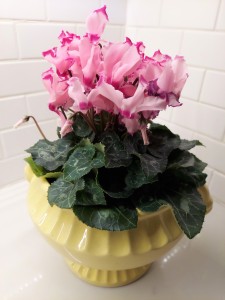 The world is full of beautiful flowers, but the most beautiful ones have fragrance to match their good looks. That is why I always thought colorful, beruffled florists’ cyclamens, also known as Cyclamen persicum, were just a little lacking. The selective breeding that transformed an eastern Mediterranean wildflower into a modern-day floral celebrity resulted in bigger, brighter flowers, but took away any scent their ancestors might have had.
The world is full of beautiful flowers, but the most beautiful ones have fragrance to match their good looks. That is why I always thought colorful, beruffled florists’ cyclamens, also known as Cyclamen persicum, were just a little lacking. The selective breeding that transformed an eastern Mediterranean wildflower into a modern-day floral celebrity resulted in bigger, brighter flowers, but took away any scent their ancestors might have had.
Now that situation has been rectified, probably because fragrant flowers have come back into fashion, and marketers have told breeders to make it a priority.
The situation began to change around 2000, when hybridizers began crossing Cyclamen persicum with a fragrant Mediterranean species, Cyclamen purpurascens. The resulting plants were somewhat smaller than standard florists’ cyclamens, but boasted pronounced fragrance, sometimes reminiscent of roses. Now fragrant varieties are available in many places—to find them just follow your nose in the greenhouse section of a well-stocked nursery or garden center. If plants are tagged, look for varieties in the trademarked Laser or Miracle series.
I did just that a few days ago and came home with a frilly pink and white specimen with essence of rose clinging to every petal. The scent is sufficiently strong to hold its own even against the competing holiday aromas of fresh baked goodies and abundant evergreens.
Whether or not it is full of fragrance, florists’ cyclamen is full of contradictions.
Despite the Latin name, the forbearers of today’s plants were not found in Persia (modern-day Iran), but hailed from nearby countries including Syria, Turkey, Lebanon, Israel, Jordan, Algeria and Tunisia. Though the flowers are orchid-like, cyclamens actually reside in the primrose or Primulaceae family. The leaves are also cleverly disguised, with patterning that might be mistaken for marble or damask fabric.
Fortunately buyers pay no attention to such contradictions and are easily beguiled by cyclamen’s ravishing good looks. Every winter thousands of the plants fly off merchandisers’ shelves and touch down gracefully in homes, offices, houses of worship and other public and private spaces.
Rising six to 10 inches tall and equally wide, cyclamen plants dazzle with basal mounds of heart-shaped leaves marbled with swirling silver bands. Slender stems rise from those mounds, supporting nodding buds that resemble tightly furled umbrellas. Once open, each bloom features three, backswept petals that may be pink, red, violet, lavender, white, or combinations of those colors. The petal edges are smooth, wavy, or exuberantly ruffled. The cumulative effect of swaying stems and vibrant colors leads some people to liken the flowers’ appearance to flocks of butterflies.
Cyclamen persicum made it to Europe around 1700, but breeders first took an interest in the early nineteenth century and have been fussing with them ever since in England, continental Europe and Japan. All that breeding and propagating work set the stage for a wave of flashy cyclamen to burst onto the mass merchandising scene nearly fifty years ago.
That wave is still cresting, with hybridizers producing both larger and smaller plants with a wider range of flower colors and configurations. Double flowers and contrasting or “picotee” petal edges have become common. I love yellow blooms and now, if you know where to look, you can buy seeds for yellow-flowered varieties like ‘Portal Cool Yellow’.
Plain or fancy, all florists’ cyclamens need care once they arrive home from the store. “Care” means removing the decorative foil around the pot and positioning it in a cool place with bright, indirect light. A surplus of direct sun will caused scorched leaves.
High humidity is a plus, so mist regularly or place the pot atop a saucer filled with pebbles. Add water to the saucer, but make sure the base of the pot is not submerged. Cyclamen appreciate moisture, but detest wet feet. Water when the top of the soil is dry and aim the spout of your watering can around the edges of the pot.
With proper care a cyclamen that leaves the store with some open flowers and a few buds should bloom for three or more weeks. Once the bloom period is over, gradually cut down on watering until the plant goes into dormancy. This is the point when most people give up, thinking that it has died. Instead of doing that, you may want to try for a second cyclamen act. Store the pot somewhere cool and moderately dry and leave it there through the end of summer. Around Labor Day, attempt a resurrection by soaking the soil thoroughly and bringing the pot back to a spot with bright, indirect light. Wait until you see signs of sprouting before watering again and then resume a regular watering schedule. Feed with commercial houseplant fertilizer according to package directions. With a bit of luck, your lovely plant will begin its growth cycle all over again.
If for some reason the cyclamen has actually died, skip the guilt and purchase another one. The death was probably not your fault. When thousands of plants are raised in a carefully controlled environment, forced into bloom at a specific time, shipped long distances, and stored under indeterminate conditions, some may not have a second season’s worth of energy.
Ironically, in the Victorian language of flowers, cyclamens, which seem so bright and cheerful during the winter, are symbolic of goodbyes. Buy one and use it to say goodbye to the old year and a bright hello to the new one.
